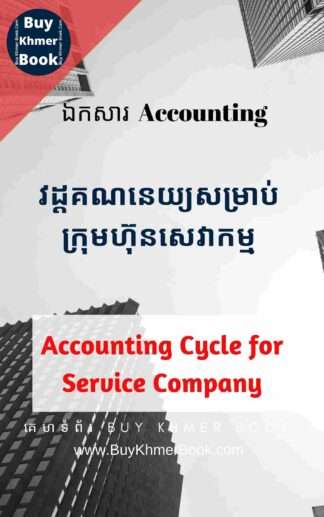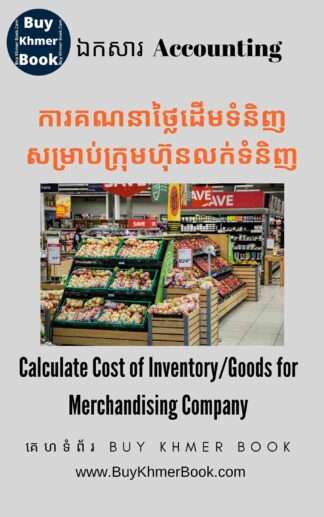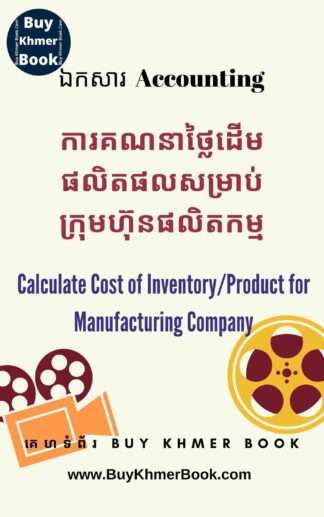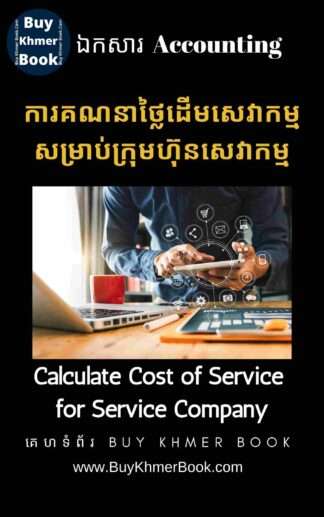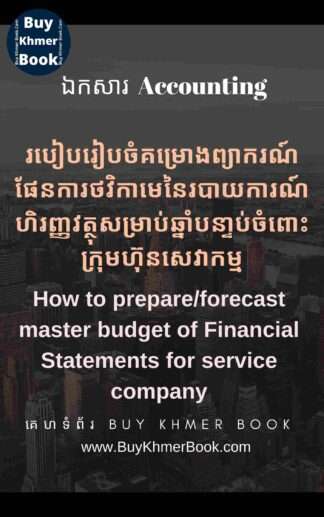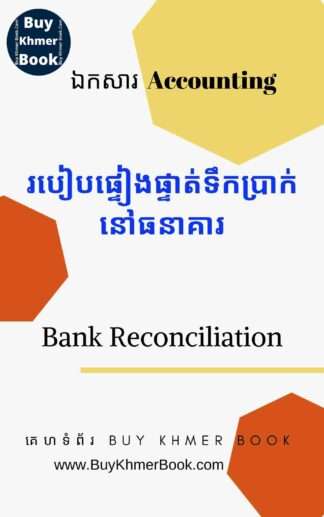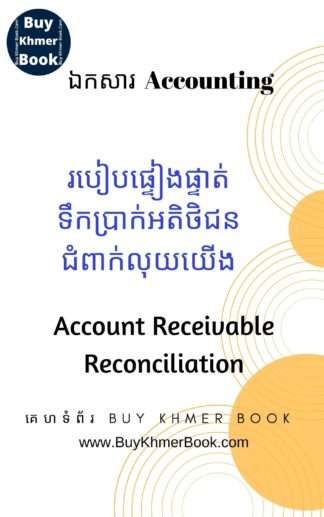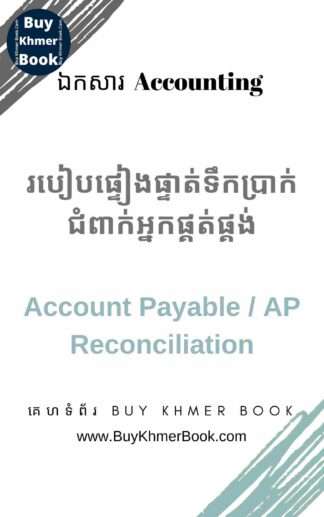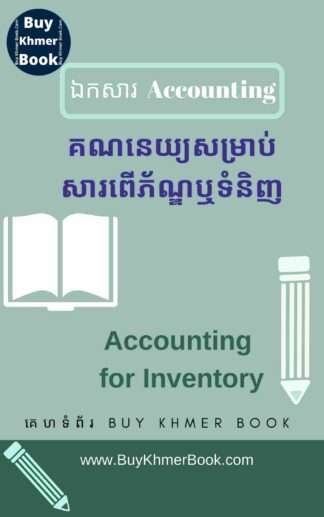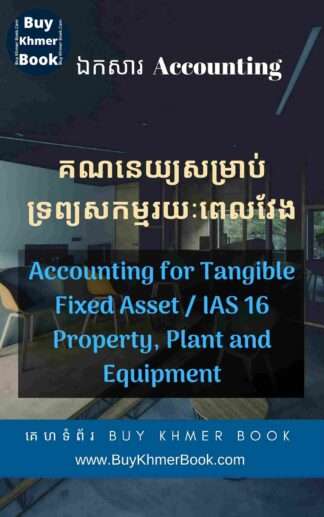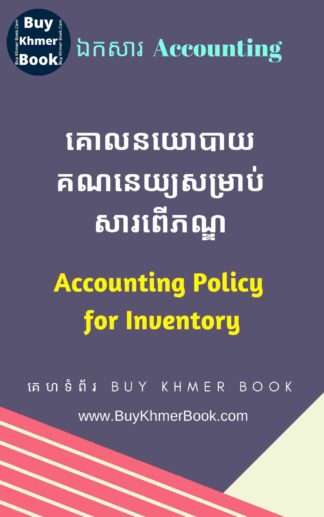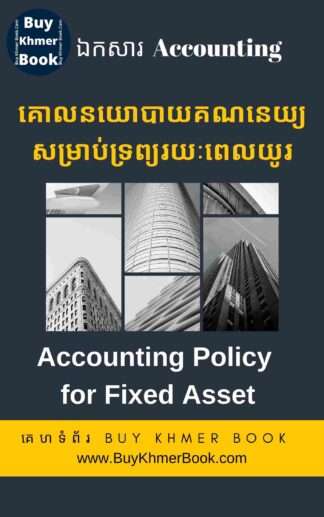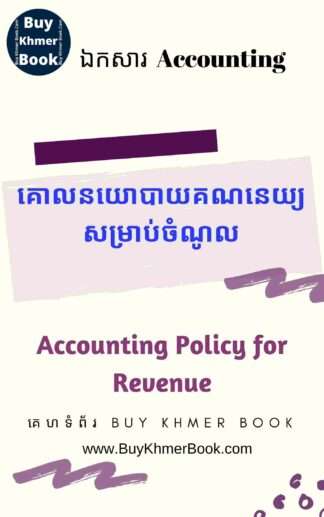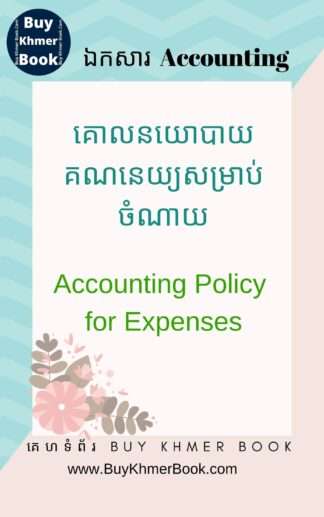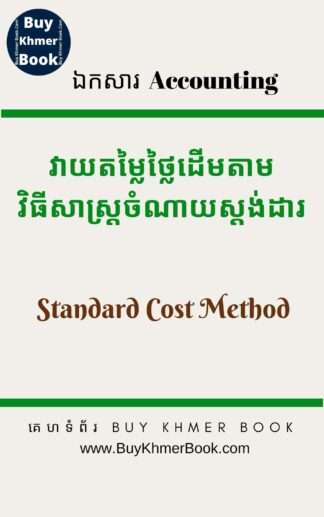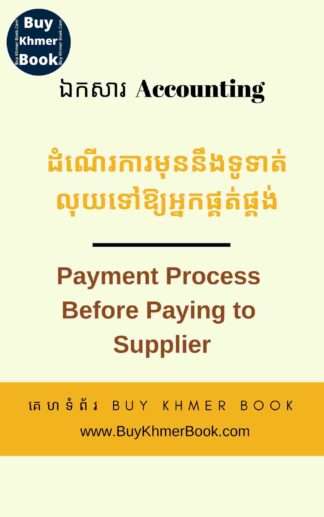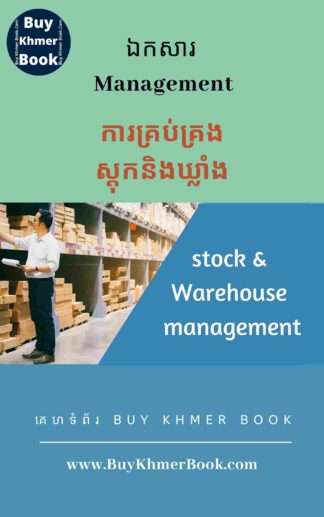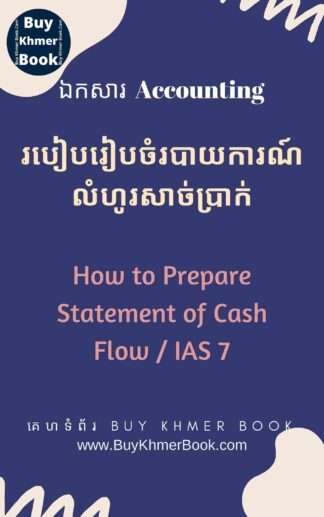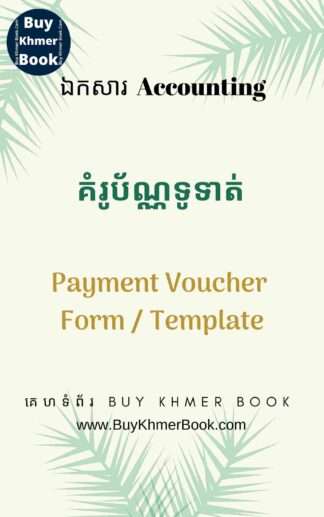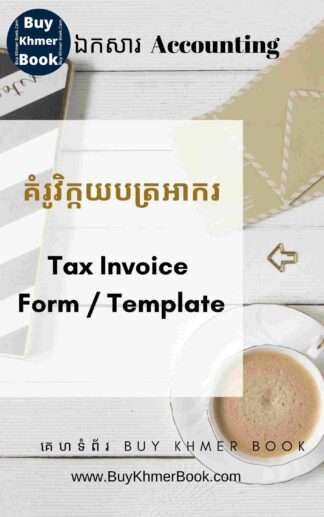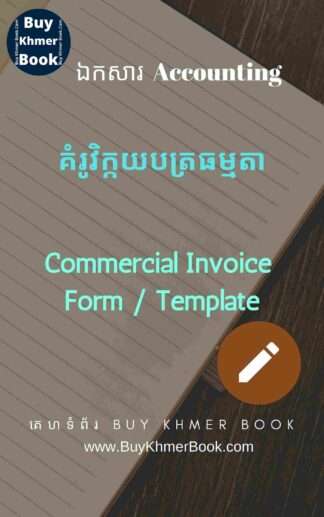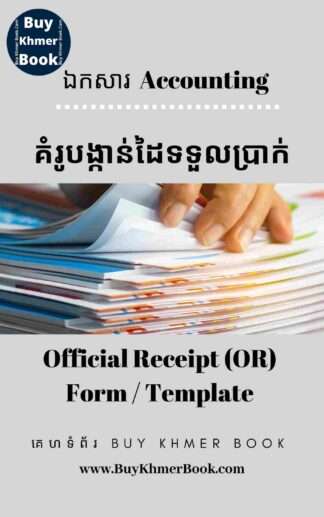Showing 1–32 of 215 results
-

គណនេយ្យសម្រាប់អ្នកមិនទាន់ចេះចាប់ផ្តើមពីការកត់ត្រាដំបូងរហូតដល់បិទបញ្ជីគណនេយ្យ និង គណនេយ្យសម្រាប់ក្រុមហ៊ុនសេវាកម្ម (Accounting Cycle for Beginner and Service Company)
$8 ចុចទិញឯកសារខាងលើនេះ -

ការគណនាថ្លៃដើមទំនិញសម្រាប់ក្រុមហ៊ុនលក់ទំនិញ និងក្រុមហ៊ុននាំចូលទំនិញ(Calculate Cost of Inventory/Goods for Merchandising, Import & Export Company)
$3 ចុចទិញឯកសារខាងលើនេះ -

ការគណនាថ្លៃដើមផលិតផលសម្រាប់ក្រុមហ៊ុនផលិតកម្ម តាមបែបអនុវត្តព្រមទាំងតាមវិធីសាស្រ្ត Absorption Costing និង ABC (Calculate Cost of Inventory/Product for Manufacturing Company Using Practical Way, Absorption Costing, Activity Based Costing (ABC) )
$7 ចុចទិញឯកសារខាងលើនេះ -

ការគណនាថ្លៃដើមសេវាកម្មសម្រាប់ក្រុមហ៊ុនសេវាកម្ម(Calculate Cost of Service for Service Company)
$3 ចុចទិញឯកសារខាងលើនេះ -

របៀបរៀបចំគំរោងព្យាករណ៏ផែនការថវិកាមេនៃរបាយការណ៍ហិរញ្ញវត្ថុសំរាប់ឆ្នាំបន្ទាប់ចំពោះក្រុមហ៊ុនផលិតកម្ម(How to prepare/forecast master budget of Financial Statements for manufacturing company)
$8 ចុចទិញឯកសារខាងលើនេះ -

របៀបរៀបចំគំរោងព្យាករណ៏ផែនការថវិកាមេនៃរបាយការណ៍ហិរញ្ញវត្ថុសំរាប់ឆ្នាំបន្ទាប់ចំពោះក្រុមហ៊ុនលក់ទំនិញ(How to prepare/forecast master budget of Financial Statements for merchandising company)
$6 ចុចទិញឯកសារខាងលើនេះ -

របៀបរៀបចំគំរោងព្យាករណ៏ផែនការថវិកាមេនៃរបាយការណ៍ហិរញ្ញវត្ថុសំរាប់ឆ្នាំបន្ទាប់ចំពោះក្រុមហ៊ុនសេវាកម្ម(How to prepare/forecast master budget of Financial Statements for service company)
$6 ចុចទិញឯកសារខាងលើនេះ -

របៀបផ្ទៀងផ្ទាត់ទឹកប្រាក់នៅធនាគារ (Bank Reconciliation)
$3 ចុចទិញឯកសារខាងលើនេះ -

របៀបផ្ទៀងផ្ទាត់ទឹកប្រាក់អតិថិជនជំពាក់លុយយើង (Account Receivable Reconciliation)
$3 ចុចទិញឯកសារខាងលើនេះ -

របៀបផ្ទៀងផ្ទាត់ទឹកប្រាក់ជំពាក់អ្នកផ្គត់ផ្គង់ (Account Payable / AP Reconciliation)
$3 ចុចទិញឯកសារខាងលើនេះ -

រៀនពីរបៀបកត់ត្រានិងចុះបញ្ជីគណនេយ្យអោយបានត្រឹមត្រូវ (Double Entry Bookkeeping / Journal Entry )
$5 ចុចទិញឯកសារខាងលើនេះ -

ការកត់ត្រាគណនេយ្យសម្រាប់អាករលើតម្លៃបន្ថែមលើធាតុចូលនិងធាតុចេញ (Accounting Record for VAT Input and VAT Output )
$2 ចុចទិញឯកសារខាងលើនេះ -

គណនេយ្យសម្រាប់សន្និធិ (Accounting for Inventory / IAS 2 ))
$9 ចុចទិញឯកសារខាងលើនេះ -

គណនេយ្យសម្រាប់ទ្រព្យសកម្មរយៈពេលវែង ឬ ទ្រព្យ រោងចក្រ និង បរិក្ខារ(Accounting for Tangible Fixed Asset / IAS 16 Property, Plant and Equipment )
$9 ចុចទិញឯកសារខាងលើនេះ -

ការបង្កើតគណនីបណ្តោះអាសន្ននិងការកែកំហុសផ្សេងៗ រួមទាំងគណនេយ្យសម្រាប់ឯកសារមិនពេញលេញ (Suspense Account and Error Correction | Incomplete Accounting Records )
$5 ចុចទិញឯកសារខាងលើនេះ -

គោលនយោបាយគណនេយ្យសម្រាប់សន្និធិ (Accounting Policy for Inventory)
$4 ចុចទិញឯកសារខាងលើនេះ -

គោលនយោបាយគណនេយ្យសម្រាប់ទ្រព្យសកម្មរយៈពេលវែង (Accounting Policy for Fixed Asset)
$4 ចុចទិញឯកសារខាងលើនេះ -

គោលនយោបាយគណនេយ្យសម្រាប់ចំណូល (Accounting Policy for Revenue)
$5 ចុចទិញឯកសារខាងលើនេះ -

គោលនយោបាយគណនេយ្យសម្រាប់ចំណាយ(Accounting Policy for Expenses)
$5 ចុចទិញឯកសារខាងលើនេះ -

គោលនយោបាយគណនេយ្យសម្រាប់បំណុល (Accounting Policy for Liability)
$5 ចុចទិញឯកសារខាងលើនេះ -

វិធីសាស្រ្តគណនាថ្លៃដើមសន្និធិ (Cost Formulas for Inventory: Standard Costing , Retail, Specific, FIFO, Average Cost)
$5 ចុចទិញឯកសារខាងលើនេះ -

ដំណើរការនៃការទិញទំនិញឬសេវានិងដំណើរការមុននឹងទូទាត់លុយទៅឱ្យអ្នកផ្គត់ផ្គង់(Purchasing Process and Payment Process Before Paying To supplier)
$6 ចុចទិញឯកសារខាងលើនេះ -

របៀបគ្រប់គ្រង់ស្តុកឬសន្និធិ និង ឃ្លាំង រួមទាំងគណនាស្តុកតាម EOQ ( Managing Stock and Warehouse Including Economic Order Quantity)
$6 ចុចទិញឯកសារខាងលើនេះ -

ការគ្រប់គ្រងប្រាក់បៀវត្សរ៍បុគ្គលិក (Payroll / Salary Management)
$3 ចុចទិញឯកសារខាងលើនេះ -

របៀបរៀបចំរបាយការណ៍ប្រាក់ចំណេញ ខាត ឬលទ្ធផលនិងទម្រង់របាយការណ៍ (How to Prepare Income Statement and Format)
$3 ចុចទិញឯកសារខាងលើនេះ -

របៀបរៀបចំតារាងតុល្យការនិងទម្រង់តារាងតុល្យការ (How to Prepare Balance Sheet/ Statement of Financial Position and Format)
$4 ចុចទិញឯកសារខាងលើនេះ -

របៀបរៀបចំរបាយការណ៍លំហូរសាច់ប្រាក់ (How to Prepare Statement of Cash Flow / IAS 7)
$9 ចុចទិញឯកសារខាងលើនេះ -

គំរូប័ណ្ណទូទាត់ ( Payment Voucher Form / Template )
$2 ចុចទិញឯកសារខាងលើនេះ -

គំរូវិក្កយបត្រអាករ (Tax Invoice Form / Template)
$2 ចុចទិញឯកសារខាងលើនេះ -

គំរូវិក្កយបត្រធម្មតា ( Commercial Invoice Form / Template)
$2 ចុចទិញឯកសារខាងលើនេះ -

គំរូបង្កាន់ដៃទទួលប្រាក់ (Official Receipt Form / Template )
$2 ចុចទិញឯកសារខាងលើនេះ -

គំរូប័ណ្ណប្រគល់ទំនិញ ( Delivery Note (DN) Form / Template )
$2 ចុចទិញឯកសារខាងលើនេះ
Showing 1–32 of 215 results
Website “Buy Khmer Book” is best online books/documents for study that you can buy anytime with best quality.
Our writers are experienced persons or graduated ACCA (CAP), MBA, Tax Agent and Diploma in Cambodia Tax. They will share best knowledge and real practice in Cambodia Context. We get positive feedback from our valued customers and customer returned to buy our documents/books again and again.
After you purchased our documents/ books , you will become our members that you can ask any questions for relevant topics purchased by you. Despite answers for your questions are not our obligation, but we try to our best to support you, so you can drop questions via this link @ https://buykhmerbook.com/my-account/ .
If you cannot find topic/ book for your requirement, you can drop topic/ Books that you require and we will find for you and solve your requirement as soon as possible via this email @ buykhmerbook@gmail.com or this link @ https://buykhmerbook.com/search-book/
Below are topics/ books that you sell on our website about accounting:
- Account Payable / AP Reconciliation
- Account Receivable Reconciliation
- Accounting for Income tax
- Accounting for Inventory
- Accounting for Investment in Associate
- Accounting for Tangible Fixed Asset
- Accounting Policy for Expenses
- Accounting Policy for Fixed Asset
- Accounting Policy for Liability
- Accounting Policy for Revenue
- Balance Sheet / Statement of Financial Position Format
- Bank Reconciliation
- Changes in accounting estimates
- Changes in accounting policy
- Commercial Invoice Form / Template
- Credit Note Form / Template
- Debit Note Form / Template
- Delivery Note (DN) Form / Template
- Difference between Capital Expenditure and Revenue Expenditure
- Double Entry Bookkeeping
- Goods Received Note (GRN) Form / Template
- Goodwill
- How to Prepare Balance Sheet
- How to prepare consolidated Balance Sheet / statement of financial position
- How to prepare consolidated Statement of Cash Flow
- How to Prepare Income Statement
- How to prepare Income Statement / consolidated statement of profit or loss and other comprehensive income
- How to Prepare Statement of Cash Flow
- How to record inventory adjustment
- How to Record Sale Tax (VAT output/ VAT input)
- IAS 23 Borrowing costs-summary
- IAS 36 Impairment of assets-Summary
- IAS 37: Provisions, contingent liabilities and contingent assets-summary
- IAS 40 Investment Property-Summary
- IAS 41: Accounting for Agriculture
- IFRS 5 Non-current assets held for sale and discontinued operations-summary
- Income Statement (Statement of profit or loss and other comprehensive income) Format
- Inventory Transfer Form / Template
- Material Request Form / Template
- Negative goodwill
- Official Receipt (OR) Form / Template
- Payment Voucher Form / Template
- Payroll Management
- Prepayment
- Prior period errors- Omissions from and misstatements in the entity’s financial statements for one or more periods
- Provision & Contingent Liability
- Purchase Order Form / Template
- Quotation Form / Template
- Sale Order Form / Template
- Statement of changes in equity format
- Subsequent expenditure for recognizing as tangible asset
- Suspense Accounts
- Unearned Revenue
- work sheet for preparing income statement and balance sheet
- Journal Entry for Account Receivable
- Journal Entry for Account Payable
- periodic inventory system និង perpetual inventory system
- Calculate Cost of Inventory/Goods for Merchandising Company)
- Calculate Cost of Inventory/Product for Manufacturing Company)
- Calculate Cost of Service for Service Company
- Tax Invoice Form / Template
- Accounting Policy for Inventory
- Accrued Expense
- Payment Process Before Paying To supplier
- How to prepare/forecast master budget of Financial Statements for manufacturing company)
- How to prepare/forecast master budget of Financial Statements for merchandising company
- How to prepare/forecast master budget of Financial Statements for service company
- Accounting Cycle
- standard cost method
- FIFO (First-In First-Out )
- Specific identification cost method
- weighted average cost method
- retail cost method
- More Books @ https://buykhmerbook.com/product-category/e-book-file-accounting/
Accounting ខាងលើទាក់ទងនឹងប្រធានបទខាងក្រោម៖
- accounting software
- accounting principles
- financial accounting
- accounting jobs
- types of accounting
- accounting course
- accounting books
- accounting courses
- គណនេយ្យ pdf
- និយមន័យគណនេយ្យ
- មេរៀនគណនេយ្យ
- ការងារ គណនេយ្យ
- រូបមន្តគណនេយ្យ
- លំហាត់គណនេយ្យ
- ប្រព័ន្ធគណនេយ្យ
- គណនេយ្យគ្រប់គ្រង
Accounting or Accountancy is the measurement, processing, and communication of financial and non financial information about economic entities such as businesses and corporations. Accounting, which has been called the “language of business”, measures the results of an organization’s economic activities and conveys this information to a variety of users, including investors, creditors, management, and regulators. Practitioners of accounting are known as accountants. The terms “accounting” and “financial reporting” are often used as synonyms.
Accounting can be divided into several fields including financial accounting, management accounting, external auditing, tax accounting and cost accounting. Accounting information systems are designed to support accounting functions and related activities. Financial accounting focuses on the reporting of an organization’s financial information, including the preparation of financial statements, to the external users of the information, such as investors, regulators and suppliers; and management accounting focuses on the measurement, analysis and reporting of information for internal use by management. The recording of financial transactions, so that summaries of the financials may be presented in financial reports, is known as bookkeeping, of which double-entry bookkeeping is the most common system.
Accounting has existed in various forms and levels of sophistication throughout human history. The double-entry accounting system in use today was developed in medieval Europe, particularly in Venice, and is usually attributed to the Italian mathematician and Franciscan friar Luca Pacioli. Today, accounting is facilitated by accounting organizations such as standard-setters, accounting firms and professional bodies. Financial statements are usually audited by accounting firms, and are prepared in accordance with generally accepted accounting principles (GAAP). GAAP is set by various standard-setting organizations such as the Financial Accounting Standards Board (FASB) in the United States and the Financial Reporting Council in the United Kingdom. As of 2012, “all major economies” have plans to converge towards or adopt the International Financial Reporting Standards (IFRS) (credit: https://en.wikipedia.org/wiki/Accounting).
គណនេយ្យឬគណនេយ្យគឺជាការវាស់វែងដំណើរការនិងទំនាក់ទំនងព័ត៌មានហិរញ្ញវត្ថុនិងមិនមែនហិរញ្ញវត្ថុអំពីអង្គភាពសេដ្ឋកិច្ចដូចជាអាជីវកម្មនិងសាជីវកម្ម។ គណនេយ្យដែលត្រូវបានគេហៅថា “ភាសានៃអាជីវកម្ម” វាស់លទ្ធផលនៃសកម្មភាពសេដ្ឋកិច្ចរបស់អង្គការមួយហើយបង្ហាញព័ត៌មាននេះដល់អ្នកប្រើប្រាស់ជាច្រើនរួមមានវិនិយោគិនម្ចាស់បំណុលអ្នកគ្រប់គ្រងនិងនិយតករ។ អ្នកអនុវត្តគណនេយ្យត្រូវបានគេស្គាល់ថាជាគណនេយ្យករ។ ពាក្យ “គណនេយ្យ” និង “របាយការណ៍ហិរញ្ញវត្ថុ” ត្រូវបានគេប្រើជាសទិសន័យ។
គណនេយ្យអាចត្រូវបានបែងចែកជាវិស័យជាច្រើនរួមមានគណនេយ្យហិរញ្ញវត្ថុគណនេយ្យគ្រប់គ្រងសវនកម្មខាងក្រៅគណនេយ្យពន្ធនិងគណនេយ្យចំណាយ។ ប្រព័ន្ធព័ត៌មានគណនេយ្យត្រូវបានរចនាឡើងដើម្បីគាំទ្រមុខងារគណនេយ្យនិងសកម្មភាពពាក់ព័ន្ធ។ គណនេយ្យហិរញ្ញវត្ថុផ្តោតលើការរាយការណ៍ព័ត៌មានហិរញ្ញវត្ថុរបស់អង្គការមួយដែលរួមមានការរៀបចំរបាយការណ៍ហិរញ្ញវត្ថុដល់អ្នកប្រើប្រាស់ព័ត៌មានខាងក្រៅដូចជាវិនិយោគិននិយ័តករនិងអ្នកផ្គត់ផ្គង់។ និងគណនេយ្យគ្រប់គ្រងផ្តោតលើការវាស់ស្ទង់ការវិភាគនិងការរាយការណ៍ព័ត៌មានសម្រាប់ប្រើប្រាស់ផ្ទៃក្នុងដោយគណៈគ្រប់គ្រង។ ការកត់ត្រាប្រតិបត្តិការហិរញ្ញវត្ថុដូច្នេះការសង្ខេបហិរញ្ញវត្ថុអាចត្រូវបានបង្ហាញនៅក្នុងរបាយការណ៍ហិរញ្ញវត្ថុត្រូវបានគេស្គាល់ថាជាគណនេយ្យដែលក្នុងនោះការចុះបញ្ជីទ្វេរដងគឺជាប្រព័ន្ធទូទៅបំផុត។
គណនេយ្យមាននៅក្នុងទម្រង់ផ្សេងៗគ្នានិងកម្រិតនៃភាពទំនើបទូទាំងប្រវត្ដិសាស្ដ្រមនុស្សជាតិ។ ប្រព័ន្ធគណនេយ្យធាតុទ្វេក្នុងការប្រើប្រាស់សព្វថ្ងៃត្រូវបានបង្កើតឡើងនៅអឺរ៉ុបយុគសម័យមជ្ឈិមសម័យជាពិសេសនៅទីក្រុងវេនីសហើយជាធម្មតាត្រូវបានគេសន្មតថាជាគណិតវិទូអ៊ីតាលីនិងហ្វ្រង់ស័រហ្វ្រង់ស័រ Luca Pacioli ។ សព្វថ្ងៃគណនេយ្យត្រូវបានសម្របសម្រួលដោយអង្គការគណនេយ្យដូចជាអ្នកកំណត់ស្តង់ដារក្រុមហ៊ុនគណនេយ្យនិងអង្គភាពជំនាញ។ របាយការណ៍ហិរញ្ញវត្ថុជាធម្មតាត្រូវបានធ្វើសវនកម្មដោយក្រុមហ៊ុនគណនេយ្យហើយត្រូវបានរៀបចំឡើងស្របតាមគោលការណ៍គណនេយ្យដែលត្រូវបានទទួលយកជាទូទៅ (GAAP) ។ GAAP ត្រូវបានកំណត់ដោយអង្គការកំណត់ស្តង់ដារផ្សេងៗដូចជាក្រុមប្រឹក្សាស្តង់ដាគណនេយ្យហិរញ្ញវត្ថុ (FASB) នៅសហរដ្ឋអាមេរិកនិងក្រុមប្រឹក្សារបាយការណ៍ហិរញ្ញវត្ថុនៅចក្រភពអង់គ្លេស។ គិតត្រឹមឆ្នាំ ២០១២“ សេដ្ឋកិច្ចធំ ៗ ទាំងអស់” មានផែនការឆ្ពោះទៅរកឬអនុម័តស្តង់ដាររបាយការណ៍ហិរញ្ញវត្ថុអន្តរជាតិ (IFRS) ។
